open bonnet FIAT 124 SPIDER 2018 Owner handbook (in English)
[x] Cancel search | Manufacturer: FIAT, Model Year: 2018, Model line: 124 SPIDER, Model: FIAT 124 SPIDER 2018Pages: 220, PDF Size: 3.18 MB
Page 34 of 220
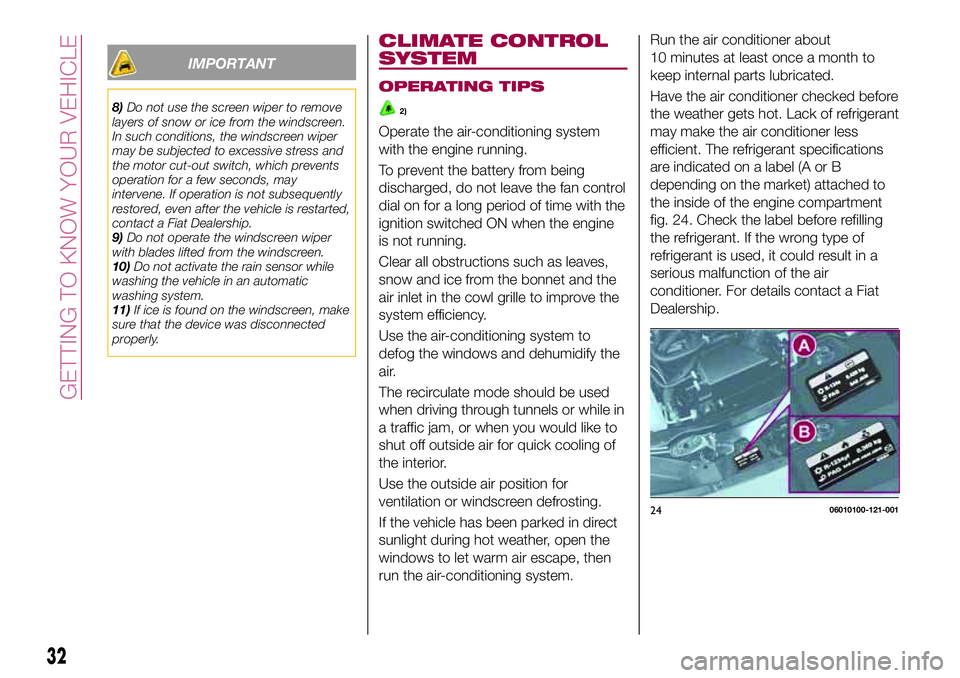
IMPORTANT
8)Do not use the screen wiper to remove
layers of snow or ice from the windscreen.
In such conditions, the windscreen wiper
may be subjected to excessive stress and
the motor cut-out switch, which prevents
operation for a few seconds, may
intervene. If operation is not subsequently
restored, even after the vehicle is restarted,
contact a Fiat Dealership.
9)Do not operate the windscreen wiper
with blades lifted from the windscreen.
10)Do not activate the rain sensor while
washing the vehicle in an automatic
washing system.
11)If ice is found on the windscreen, make
sure that the device was disconnected
properly.
CLIMATE CONTROL
SYSTEM
OPERATING TIPS
2)
Operate the air-conditioning system
with the engine running.
To prevent the battery from being
discharged, do not leave the fan control
dial on for a long period of time with the
ignition switched ON when the engine
is not running.
Clear all obstructions such as leaves,
snow and ice from the bonnet and the
air inlet in the cowl grille to improve the
system efficiency.
Use the air-conditioning system to
defog the windows and dehumidify the
air.
The recirculate mode should be used
when driving through tunnels or while in
a traffic jam, or when you would like to
shut off outside air for quick cooling of
the interior.
Use the outside air position for
ventilation or windscreen defrosting.
If the vehicle has been parked in direct
sunlight during hot weather, open the
windows to let warm air escape, then
run the air-conditioning system.Run the air conditioner about
10 minutes at least once a month to
keep internal parts lubricated.
Have the air conditioner checked before
the weather gets hot. Lack of refrigerant
may make the air conditioner less
efficient. The refrigerant specifications
are indicated on a label (A or B
depending on the market) attached to
the inside of the engine compartment
fig. 24. Check the label before refilling
the refrigerant. If the wrong type of
refrigerant is used, it could result in a
serious malfunction of the air
conditioner. For details contact a Fiat
Dealership.
2406010100-121-001
32
GETTING TO KNOW YOUR VEHICLE
Page 44 of 220
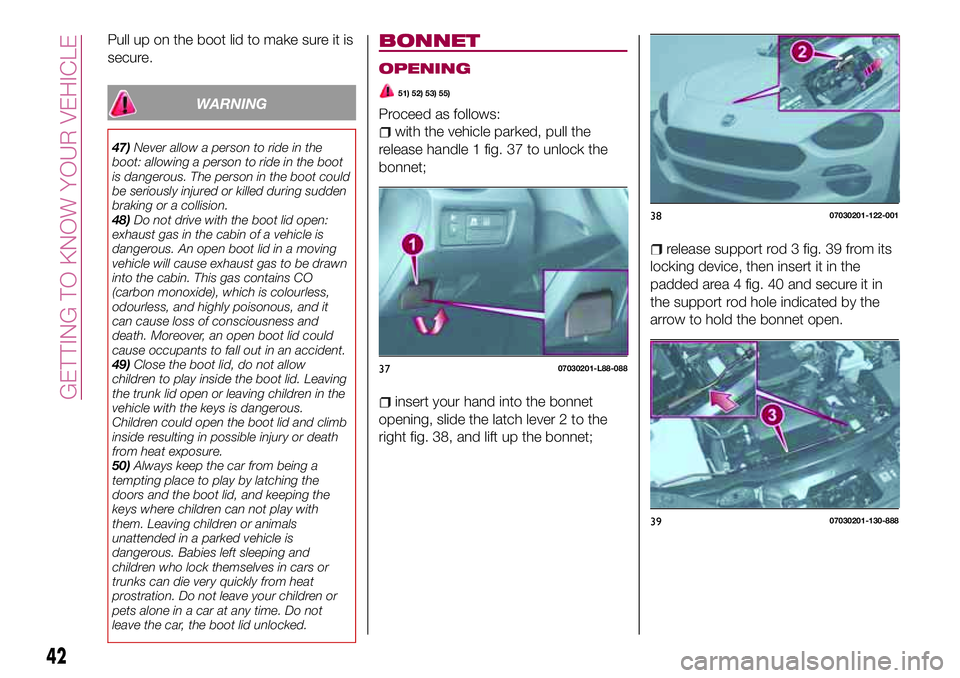
Pull up on the boot lid to make sure it is
secure.
WARNING
47)Never allow a person to ride in the
boot: allowing a person to ride in the boot
is dangerous. The person in the boot could
be seriously injured or killed during sudden
braking or a collision.
48)Do not drive with the boot lid open:
exhaust gas in the cabin of a vehicle is
dangerous. An open boot lid in a moving
vehicle will cause exhaust gas to be drawn
into the cabin. This gas contains CO
(carbon monoxide), which is colourless,
odourless, and highly poisonous, and it
can cause loss of consciousness and
death. Moreover, an open boot lid could
cause occupants to fall out in an accident.
49)Close the boot lid, do not allow
children to play inside the boot lid. Leaving
the trunk lid open or leaving children in the
vehicle with the keys is dangerous.
Children could open the boot lid and climb
inside resulting in possible injury or death
from heat exposure.
50)Always keep the car from being a
tempting place to play by latching the
doors and the boot lid, and keeping the
keys where children can not play with
them. Leaving children or animals
unattended in a parked vehicle is
dangerous. Babies left sleeping and
children who lock themselves in cars or
trunks can die very quickly from heat
prostration. Do not leave your children or
pets alone in a car at any time. Do not
leave the car, the boot lid unlocked.
BONNET
OPENING
51) 52) 53) 55)
Proceed as follows:
with the vehicle parked, pull the
release handle 1 fig. 37 to unlock the
bonnet;
insert your hand into the bonnet
opening, slide the latch lever 2 to the
right fig. 38, and lift up the bonnet;
release support rod 3 fig. 39 from its
locking device, then insert it in the
padded area 4 fig. 40 and secure it in
the support rod hole indicated by the
arrow to hold the bonnet open.
3707030201-L88-088
3807030201-122-001
3907030201-130-888
42
GETTING TO KNOW YOUR VEHICLE
Page 45 of 220
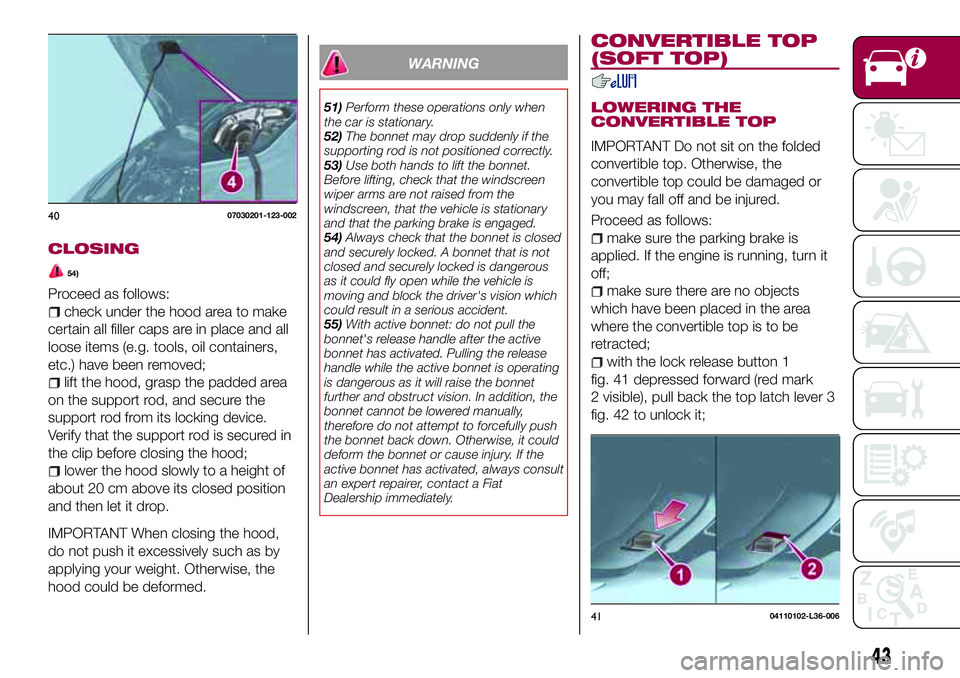
CLOSING
54)
Proceed as follows:
check under the hood area to make
certain all filler caps are in place and all
loose items (e.g. tools, oil containers,
etc.) have been removed;
lift the hood, grasp the padded area
on the support rod, and secure the
support rod from its locking device.
Verify that the support rod is secured in
the clip before closing the hood;
lower the hood slowly to a height of
about 20 cm above its closed position
and then let it drop.
IMPORTANT When closing the hood,
do not push it excessively such as by
applying your weight. Otherwise, the
hood could be deformed.
WARNING
51)Perform these operations only when
the car is stationary.
52)The bonnet may drop suddenly if the
supporting rod is not positioned correctly.
53)Use both hands to lift the bonnet.
Before lifting, check that the windscreen
wiper arms are not raised from the
windscreen, that the vehicle is stationary
and that the parking brake is engaged.
54)Always check that the bonnet is closed
and securely locked. A bonnet that is not
closed and securely locked is dangerous
as it could fly open while the vehicle is
moving and block the driver's vision which
could result in a serious accident.
55)With active bonnet: do not pull the
bonnet's release handle after the active
bonnet has activated. Pulling the release
handle while the active bonnet is operating
is dangerous as it will raise the bonnet
further and obstruct vision. In addition, the
bonnet cannot be lowered manually,
therefore do not attempt to forcefully push
the bonnet back down. Otherwise, it could
deform the bonnet or cause injury. If the
active bonnet has activated, always consult
an expert repairer, contact a Fiat
Dealership immediately.
CONVERTIBLE TOP
(SOFT TOP)
LOWERING THE
CONVERTIBLE TOP
IMPORTANT Do not sit on the folded
convertible top. Otherwise, the
convertible top could be damaged or
you may fall off and be injured.
Proceed as follows:
make sure the parking brake is
applied. If the engine is running, turn it
off;
make sure there are no objects
which have been placed in the area
where the convertible top is to be
retracted;
with the lock release button 1
fig. 41 depressed forward (red mark
2 visible), pull back the top latch lever 3
fig. 42 to unlock it;
4007030201-123-002
4104110102-L36-006
43
Page 141 of 220
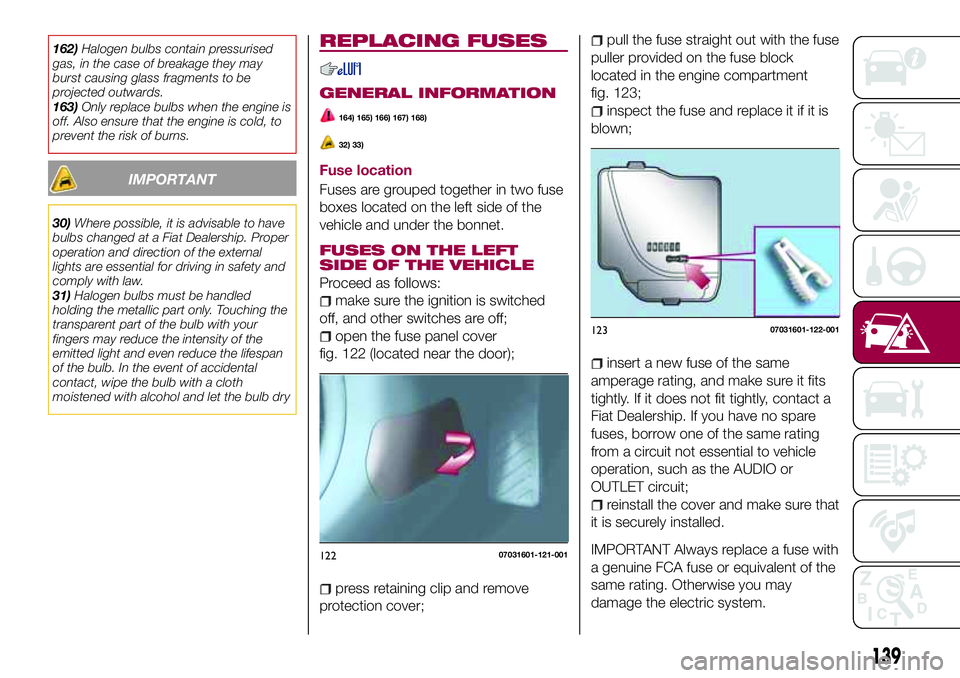
162)Halogen bulbs contain pressurised
gas, in the case of breakage they may
burst causing glass fragments to be
projected outwards.
163)Only replace bulbs when the engine is
off. Also ensure that the engine is cold, to
prevent the risk of burns.
IMPORTANT
30)Where possible, it is advisable to have
bulbs changed at a Fiat Dealership. Proper
operation and direction of the external
lights are essential for driving in safety and
comply with law.
31)Halogen bulbs must be handled
holding the metallic part only. Touching the
transparent part of the bulb with your
fingers may reduce the intensity of the
emitted light and even reduce the lifespan
of the bulb. In the event of accidental
contact, wipe the bulb with a cloth
moistened with alcohol and let the bulb dry
REPLACING FUSES
GENERAL INFORMATION
164) 165) 166) 167) 168)
32) 33)
Fuse location
Fuses are grouped together in two fuse
boxes located on the left side of the
vehicle and under the bonnet.
FUSES ON THE LEFT
SIDE OF THE VEHICLE
Proceed as follows:
make sure the ignition is switched
off, and other switches are off;
open the fuse panel cover
fig. 122 (located near the door);
press retaining clip and remove
protection cover;
pull the fuse straight out with the fuse
puller provided on the fuse block
located in the engine compartment
fig. 123;
inspect the fuse and replace it if it is
blown;
insert a new fuse of the same
amperage rating, and make sure it fits
tightly. If it does not fit tightly, contact a
Fiat Dealership. If you have no spare
fuses, borrow one of the same rating
from a circuit not essential to vehicle
operation, such as the AUDIO or
OUTLET circuit;
reinstall the cover and make sure that
it is securely installed.
IMPORTANT Always replace a fuse with
a genuine FCA fuse or equivalent of the
same rating. Otherwise you may
damage the electric system.12207031601-121-001
12307031601-122-001
139
Page 142 of 220
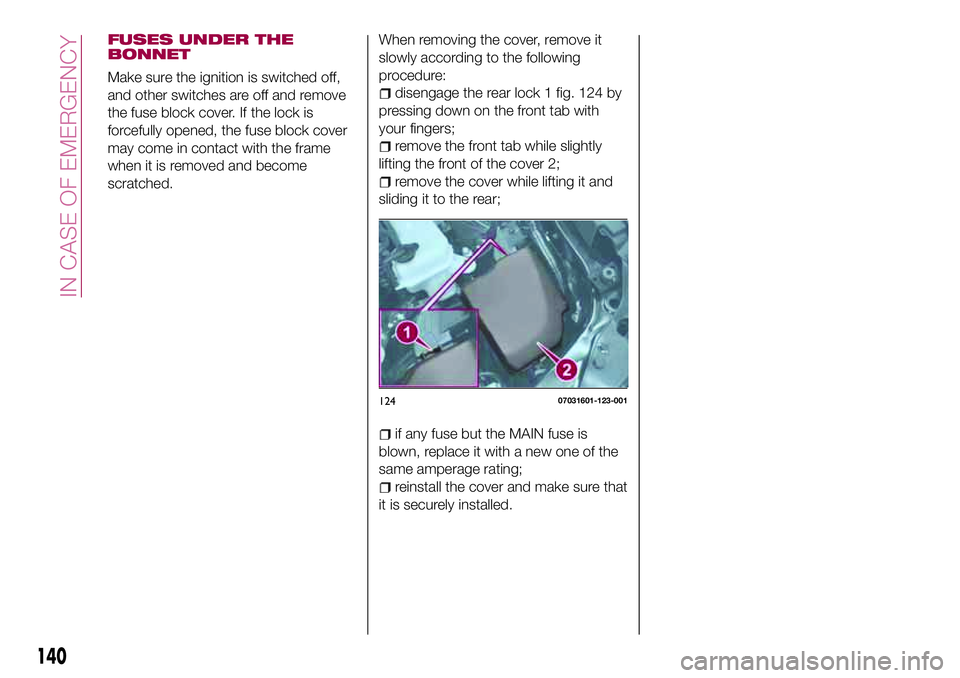
FUSES UNDER THE
BONNET
Make sure the ignition is switched off,
and other switches are off and remove
the fuse block cover. If the lock is
forcefully opened, the fuse block cover
may come in contact with the frame
when it is removed and become
scratched.When removing the cover, remove it
slowly according to the following
procedure:disengage the rear lock 1 fig. 124 by
pressing down on the front tab with
your fingers;
remove the front tab while slightly
lifting the front of the cover 2;
remove the cover while lifting it and
sliding it to the rear;
if any fuse but the MAIN fuse is
blown, replace it with a new one of the
same amperage rating;
reinstall the cover and make sure that
it is securely installed.
12407031601-123-001
140
IN CASE OF EMERGENCY
Page 154 of 220
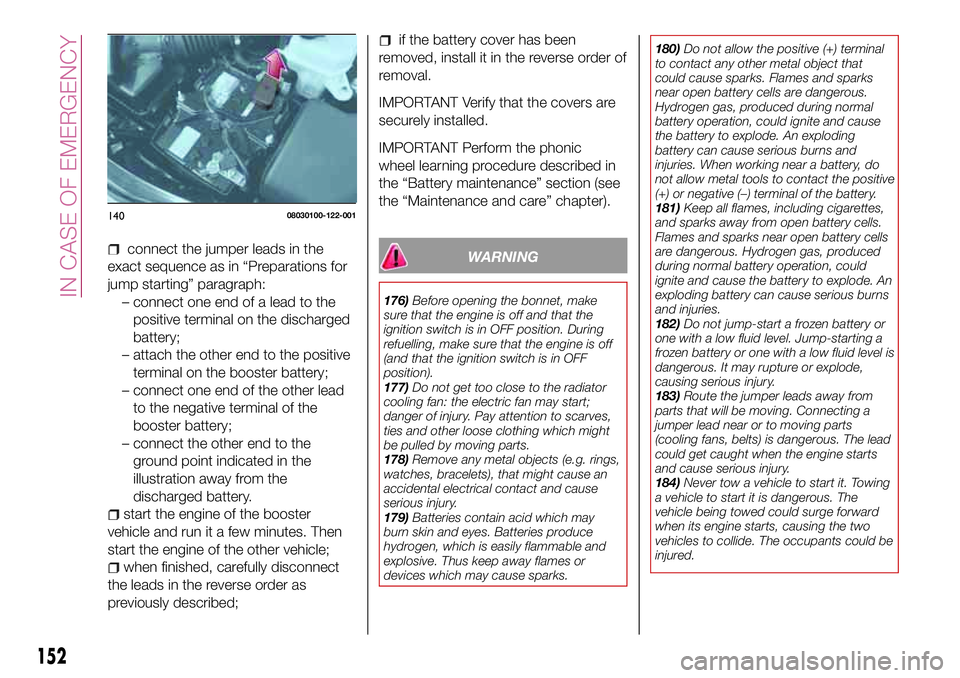
connect the jumper leads in the
exact sequence as in “Preparations for
jump starting” paragraph:
– connect one end of a lead to the
positive terminal on the discharged
battery;
– attach the other end to the positive
terminal on the booster battery;
– connect one end of the other lead
to the negative terminal of the
booster battery;
– connect the other end to the
ground point indicated in the
illustration away from the
discharged battery.
start the engine of the booster
vehicle and run it a few minutes. Then
start the engine of the other vehicle;
when finished, carefully disconnect
the leads in the reverse order as
previously described;
if the battery cover has been
removed, install it in the reverse order of
removal.
IMPORTANT Verify that the covers are
securely installed.
IMPORTANT Perform the phonic
wheel learning procedure described in
the “Battery maintenance” section (see
the “Maintenance and care” chapter).
WARNING
176)Before opening the bonnet, make
sure that the engine is off and that the
ignition switch is in OFF position. During
refuelling, make sure that the engine is off
(and that the ignition switch is in OFF
position).
177)Do not get too close to the radiator
cooling fan: the electric fan may start;
danger of injury. Pay attention to scarves,
ties and other loose clothing which might
be pulled by moving parts.
178)Remove any metal objects (e.g. rings,
watches, bracelets), that might cause an
accidental electrical contact and cause
serious injury.
179)Batteries contain acid which may
burn skin and eyes. Batteries produce
hydrogen, which is easily flammable and
explosive. Thus keep away flames or
devices which may cause sparks.180)Do not allow the positive (+) terminal
to contact any other metal object that
could cause sparks. Flames and sparks
near open battery cells are dangerous.
Hydrogen gas, produced during normal
battery operation, could ignite and cause
the battery to explode. An exploding
battery can cause serious burns and
injuries. When working near a battery, do
not allow metal tools to contact the positive
(+) or negative (–) terminal of the battery.
181)Keep all flames, including cigarettes,
and sparks away from open battery cells.
Flames and sparks near open battery cells
are dangerous. Hydrogen gas, produced
during normal battery operation, could
ignite and cause the battery to explode. An
exploding battery can cause serious burns
and injuries.
182)Do not jump-start a frozen battery or
one with a low fluid level. Jump-starting a
frozen battery or one with a low fluid level is
dangerous. It may rupture or explode,
causing serious injury.
183)Route the jumper leads away from
parts that will be moving. Connecting a
jumper lead near or to moving parts
(cooling fans, belts) is dangerous. The lead
could get caught when the engine starts
and cause serious injury.
184)Never tow a vehicle to start it. Towing
a vehicle to start it is dangerous. The
vehicle being towed could surge forward
when its engine starts, causing the two
vehicles to collide. The occupants could be
injured.
14008030100-122-001
152
IN CASE OF EMERGENCY
Page 173 of 220
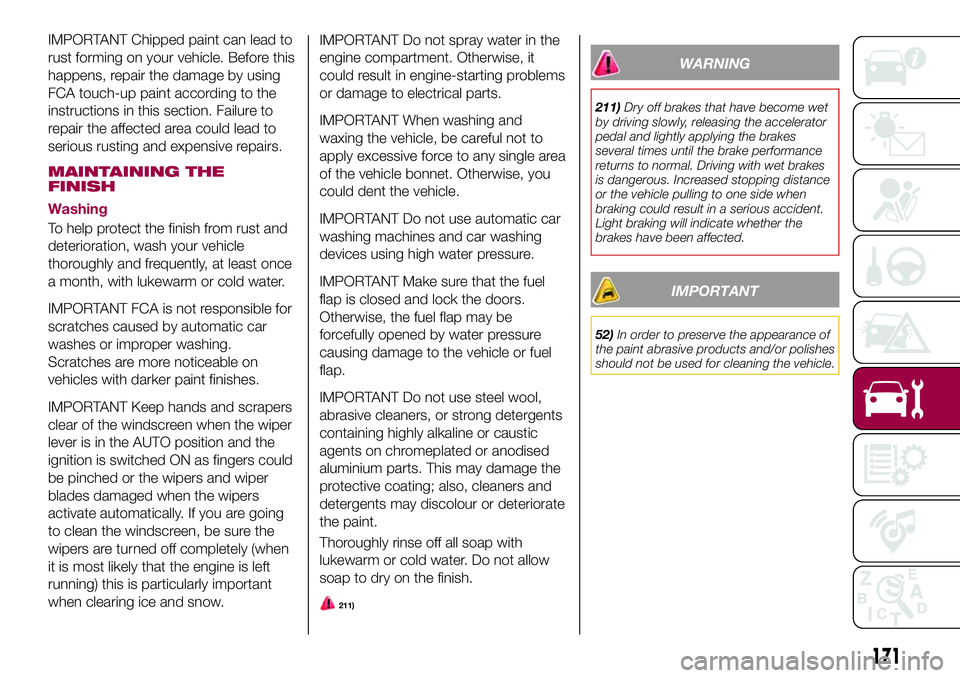
IMPORTANT Chipped paint can lead to
rust forming on your vehicle. Before this
happens, repair the damage by using
FCA touch-up paint according to the
instructions in this section. Failure to
repair the affected area could lead to
serious rusting and expensive repairs.
MAINTAINING THE
FINISH
Washing
To help protect the finish from rust and
deterioration, wash your vehicle
thoroughly and frequently, at least once
a month, with lukewarm or cold water.
IMPORTANT FCA is not responsible for
scratches caused by automatic car
washes or improper washing.
Scratches are more noticeable on
vehicles with darker paint finishes.
IMPORTANT Keep hands and scrapers
clear of the windscreen when the wiper
lever is in the AUTO position and the
ignition is switched ON as fingers could
be pinched or the wipers and wiper
blades damaged when the wipers
activate automatically. If you are going
to clean the windscreen, be sure the
wipers are turned off completely (when
it is most likely that the engine is left
running) this is particularly important
when clearing ice and snow.IMPORTANT Do not spray water in the
engine compartment. Otherwise, it
could result in engine-starting problems
or damage to electrical parts.
IMPORTANT When washing and
waxing the vehicle, be careful not to
apply excessive force to any single area
of the vehicle bonnet. Otherwise, you
could dent the vehicle.
IMPORTANT Do not use automatic car
washing machines and car washing
devices using high water pressure.
IMPORTANT Make sure that the fuel
flap is closed and lock the doors.
Otherwise, the fuel flap may be
forcefully opened by water pressure
causing damage to the vehicle or fuel
flap.
IMPORTANT Do not use steel wool,
abrasive cleaners, or strong detergents
containing highly alkaline or caustic
agents on chromeplated or anodised
aluminium parts. This may damage the
protective coating; also, cleaners and
detergents may discolour or deteriorate
the paint.
Thoroughly rinse off all soap with
lukewarm or cold water. Do not allow
soap to dry on the finish.
211)
WARNING
211)Dry off brakes that have become wet
by driving slowly, releasing the accelerator
pedal and lightly applying the brakes
several times until the brake performance
returns to normal. Driving with wet brakes
is dangerous. Increased stopping distance
or the vehicle pulling to one side when
braking could result in a serious accident.
Light braking will indicate whether the
brakes have been affected.
IMPORTANT
52)In order to preserve the appearance of
the paint abrasive products and/or polishes
should not be used for cleaning the vehicle.
171
Page 215 of 220
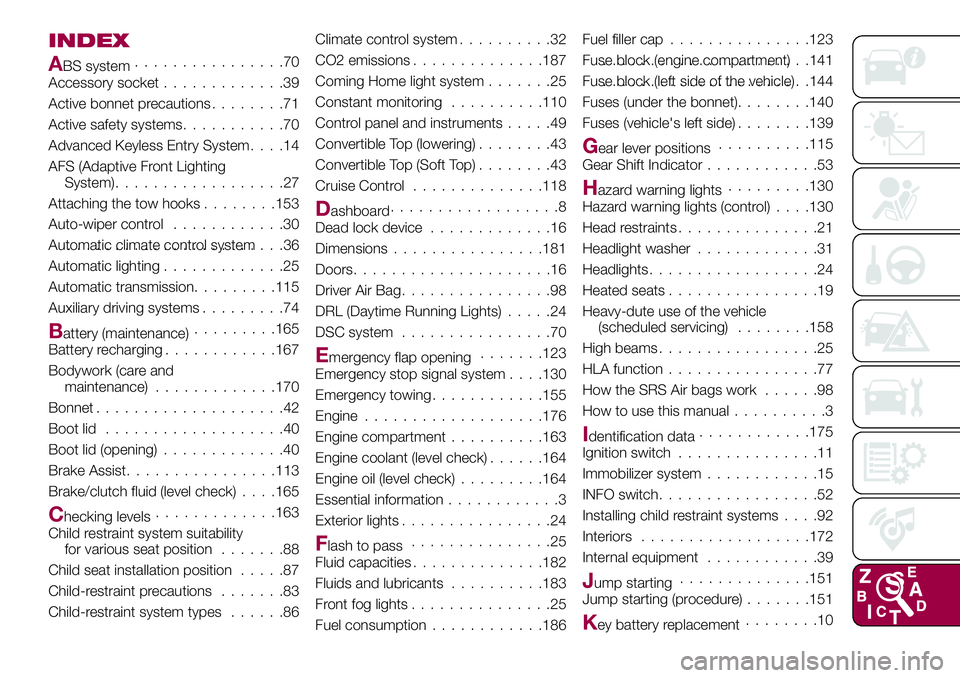
INDEX
ABS system................70
Accessory socket.............39
Active bonnet precautions........71
Active safety systems...........70
Advanced Keyless Entry System....14
AFS (Adaptive Front Lighting
System)..................27
Attaching the tow hooks........153
Auto-wiper control............30
Automatic climate control system.......................36
Automatic lighting.............25
Automatic transmission.........115
Auxiliary driving systems.........74
Battery (maintenance).........165
Battery recharging............167
Bodywork (care and
maintenance).............170
Bonnet....................42
Boot lid...................40
Boot lid (opening).............40
Brake Assist................113
Brake/clutch fluid (level check). . . .165
Checking levels.............163
Child restraint system suitability
for various seat position.......88
Child seat installation position.....87
Child-restraint precautions.......83
Child-restraint system types......86Climate control system..........32
CO2 emissions..............187
Coming Home light system.......25
Constant monitoring..........110
Control panel and instruments.....49
Convertible Top (lowering)........43
Convertible Top (Soft Top)........43
Cruise Control..............118
Dashboard..................8
Dead lock device.............16
Dimensions................181
Doors.....................16
Driver Air Bag................98
DRL (Daytime Running Lights).....24
DSC system................70
Emergency flap opening.......123
Emergency stop signal system. . . .130
Emergency towing............155
Engine...................176
Engine compartment..........163
Engine coolant (level check)......164
Engine oil (level check).........164
Essential information............3
Exterior lights................24
Flash to pass...............25
Fluid capacities..............182
Fluids and lubricants..........183
Front fog lights...............25
Fuel consumption............186Fuel filler cap...............123
Fuse block (engine compartment)......................141
Fuse block (left side of the vehicle)......................144
Fuses (under the bonnet)........140
Fuses (vehicle's left side)........139
Gear lever positions..........115
Gear Shift Indicator............53
Hazard warning lights.........130
Hazard warning lights (control). . . .130
Head restraints...............21
Headlight washer.............31
Headlights..................24
Heated seats................19
Heavy-dute use of the vehicle
(scheduled servicing)........158
High beams.................25
HLA function................77
How the SRS Air bags work......98
How to use this manual..........3
Identification data............175
Ignition switch...............11
Immobilizer system............15
INFO switch.................52
Installing child restraint systems....92
Interiors..................172
Internal equipment............39
Jump starting..............151
Jump starting (procedure).......151
Key battery replacement........10